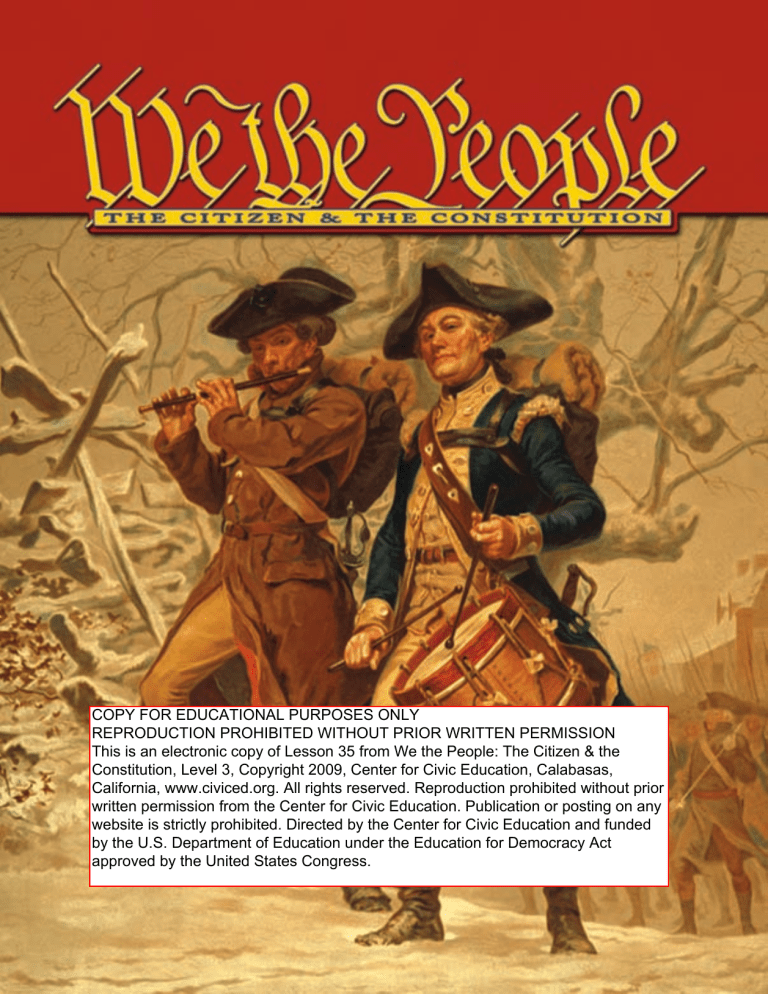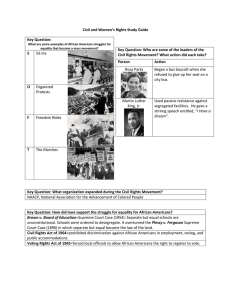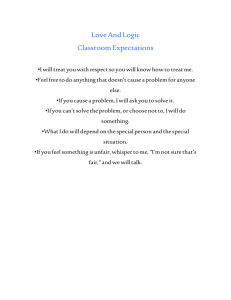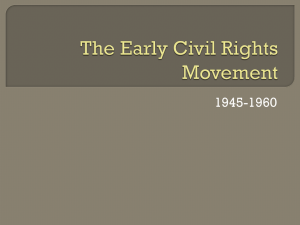
COPY FOR EDUCATIONAL PURPOSES ONLY
REPRODUCTION PROHIBITED WITHOUT PRIOR WRITTEN PERMISSION
This is an electronic copy of Lesson 35 from We the People: The Citizen & the
Constitution, Level 3, Copyright 2009, Center for Civic Education, Calabasas,
California, www.civiced.org. All rights reserved. Reproduction prohibited without prior
written permission from the Center for Civic Education. Publication or posting on any
website is strictly prohibited. Directed by the Center for Civic Education and funded
by the U.S. Department of Education under the Education for Democracy Act
approved by the United States Congress.
How does the
Constitution safeguard
the right to equal
protection of the law?
LESSON PURPOSE
In this lesson you will be introduced to one of the
most important parts of the Fourteenth Amendment
to the Constitution—the equal protection clause.
When you finish this lesson, you should be able to
explain the purpose of the equal protection clause.
You should also be able to describe some of the steps
that Congress, the executive branch, the U.S. Supreme
Court, and citizens have taken to end unfair
discrimination in our nation.
26
T E R M S T O U N D E R S TA N D
boycott
Civil Rights Act of 1964
equal protection clause
Jim Crow laws
segregation
separate but equal
How did the Constitution
end unfair treatment of
citizens by government?
Although the Thirteenth Amendment
abolished slavery in 1865, it did not end
unfair treatment of African Americans
by government. Many states in the South
passed laws that discriminated against
black people. State and local laws required
that public facilities such as restrooms,
theaters, and parks have separate areas
for black people and white people.
Congress adopted the Fourteenth
Amendment in 1868. The equal protection
clause is stated in Section 1 of the
amendment. It is the most important
constitutional protection that the people
have against unfair discrimination by
state and local governments. The equal
protection clause says that
no State shall...deny to any person
within its jurisdiction the equal
protection of the laws.
At the time it was ratified, this
clause was intended to prevent discrimination against African Americans
and guarantee them the rights that
go along with citizenship.
226
Why did the passage of the Thirteenth
Amendment fail to end unfair treatment
of African Americans?
IDEAS F OR DISCUSSION
Are these situations unfair treatment by government?
With a partner, read each of the following situations.
Explain to the class why each is or is not unfair government treatment.
� In your state there is a law that says
students belonging to a certain race
must go to schools that are separate
from those that other students attend.
� Your city has a regulation requiring
people with particular religious beliefs
to live in a special section of town.
� Your city fire department will
not hire women as firefighters.
� You and a friend of the opposite
sex work for the state. You both
do the same jobs. Yet you are
each paid at a different rate.
� Your state has a law that says people
must marry within their own race.
Under what conditions, if any, would it be fair to pay people at
a different rate for doing the same work? Explain your reasoning.
227
The Fourteenth Amendment did not
by itself prevent discrimination, however.
The states continued to pass laws requiring
African Americans to go to separate schools
and to use separate public facilities. These
laws came to be called Jim Crow laws.
The states claimed that such laws did not
violate the equal protection clause because
the separate schools and facilities for blacks
were equal to those provided for whites.
This is known as the separate but equal
argument. The U.S. Supreme Court considered this argument in two famous
cases: Plessy v. Ferguson (1896) and
Brown v. Board of Education (1954).
How did the U.S. Supreme
Court interpret the equal
protection clause in two
separate cases?
CASE ONE
Plessy v. Ferguson (1896)
The state of Louisiana passed a law
requiring railroad companies to provide
separate, similar cars for white passengers and black passengers. A group
of African American leaders decided
to challenge the law.
In what ways did Jim Crow laws violate the equal protection clause?
228
Homer Plessy bought a railroad ticket
and took a seat in a car set aside for whites.
Plessy was arrested when he refused to
move. The Louisiana state court found
him guilty of violating state law. Plessy
took his case to the U.S. Supreme
Court, arguing that the Louisiana law
violated the equal protection clause.
The Supreme Court ruled against
Plessy. The Court said that separating
the races did not mean that one race
was inferior to the other. Because the
state law required the facilities to be
separate but equal, the Supreme Court
said there was no discrimination.
The decision in this case, Plessy v.
Ferguson (1896), allowed states to practice
segregation, separation of the races, for
almost sixty years. Then, in the case of
Brown v. Board of Education (1954), the
U.S. Supreme Court changed its interpretation of the equal protection clause.
This time the Court agreed. It said that
placing African American children in
schools separate from white children
denied them the equal protection of
the laws guaranteed by the Fourteenth
Amendment. The Court said,
To separate [children]...solely
because of their race generates
[causes] a feeling of inferiority...
that may affect their hearts and
minds in a way unlikely ever to
be undone.
CASE TWO
Brown v. Board of Education (1954)
Linda Brown was a seven-year-old
child who lived five blocks from an
elementary school. Linda was forced to
attend a school for African American
children twenty-one blocks away from her
home. Linda’s parents, along with twelve
other parents, brought a lawsuit against
the school board of Topeka, Kansas, saying their children had been deprived
of equal protection of the law.
One of the lawyers for the parents was
Thurgood Marshall, an attorney for the
National Association for the Advancement
of Colored People. Marshall later became
the first African American justice of the
U.S. Supreme Court. He argued that
segregated schools could not be equal.
These are the lawyers for the Brown family
and the other families: George E.C. Hayes, left,
Thurgood Marshall, center, and James M. Nabrit Jr.
What was their argument before the Supreme
Court? How did the Court rule in this case?
229
How did Congress,
the executive branch,
and citizens work to end
unfair discrimination
by government?
The Court’s decision in Brown v. Board
of Education was the first important step
in ending school segregation. Although
the Brown case was a turning point in
the fight against discrimination, it dealt
only with segregated schools. The Court
decision by itself did not end discrimination. Many states resisted the Court’s
order to integrate their schools. As late
as 1957, the governor of Arkansas tried
to stop black students from entering a
What means did leaders of the civil rights
movement use to obtain their goals?
Who is Rosa Parks? Why did African
Americans begin a boycott of buses in
Montgomery, Alabama, in 1955?
230
white high school in Little Rock. In
response, President Dwight Eisenhower
ordered federal troops to escort the
students and enforce the law.
The civil rights movement started in
the 1950s. It was a time when many people
of both races worked to end unfair treatment by government. People marched in
the streets. They wrote letters to Congress
asking for stronger laws. They held boycotts.
A boycott means that they refused to buy
from or deal with stores and companies
that practiced racial discrimination.
One of the earliest boycotts began in
1955. Rosa Parks was a working woman
who lived in Montgomery, Alabama. She
was on her way home one day when the
bus she was riding became crowded.
Parks refused to give up her seat to a
What democratic ideals were expressed by Martin Luther King Jr. in his “I Have a Dream” speech?
white man. She was arrested for violating
a city law. The African American community boycotted the city buses until
the city changed the law. The boycott
lasted more than a year.
In August of 1963, thousands of
Americans marched in Washington, D.C.
They wanted to show their support for
the civil rights movement. Dr. Martin
Luther King Jr. was an important civil
rights leader. It was here that Dr. King
gave his famous “I Have a Dream” speech.
King told the crowd, “I have a dream that
my four little children will one day live
in a nation where they will not be judged
by the color of their skin, but by the
content of their character.” One day, he
hoped, all people would join hands
and be “free at last.”
In 1964, Congress passed the Civil
Rights Act. The Civil Rights Act of 1964
ended segregation in public places such
as restaurants and hotels. The law also
said that employers could not discriminate
against people because of their race,
national origin, religion, or gender.
When African Americans won these
civil rights after years of struggle, other
groups began to call for equal protection.
Women, disabled people, older people, and
other groups worked to get laws passed
guaranteeing their right to equal protection of the laws. In response to their
efforts, Congress and state legislatures
have passed laws prohibiting unfair
discrimination against these groups.
231
LESSON R EVIE W
� What was the purpose of the
� What actions did ordinary
Thirteenth and Fourteenth
Amendments to the Constitution?
citizens take to help end unfair
discrimination?
� What is the meaning of the equal
� What laws did Congress pass to
protection clause? Why is this
clause important?
� What did the U.S. Supreme Court
decide in the Plessy v. Ferguson
help end unfair discrimination?
� What actions did the executive
branch take to help end unfair
discrimination?
case? What effects did the decision
have on the lives of African
Americans?
� What did the U.S. Supreme Court
decide in the Brown v. Board of
Education case? Why was this
an important decision?
ACTIVITI E S
� Research information about Martin
Luther King Jr. Read his Letter from
Birmingham City Jail. What kinds
of inspiration did he have for his
ideas about nonviolence? Share
what you learned with the class.
� “Equal treatment” continues to be an
important issue in the United States
today. Find information about issues
of equality that organized groups
are seeking to address today. Explain
what these issues are in a report
to your class.
232
� Create a timeline of historical events
in the struggle to gain equal protection by various groups in America.
Each student should research one
event to include in a classroom poster
commemorating the struggle for
equal rights.





